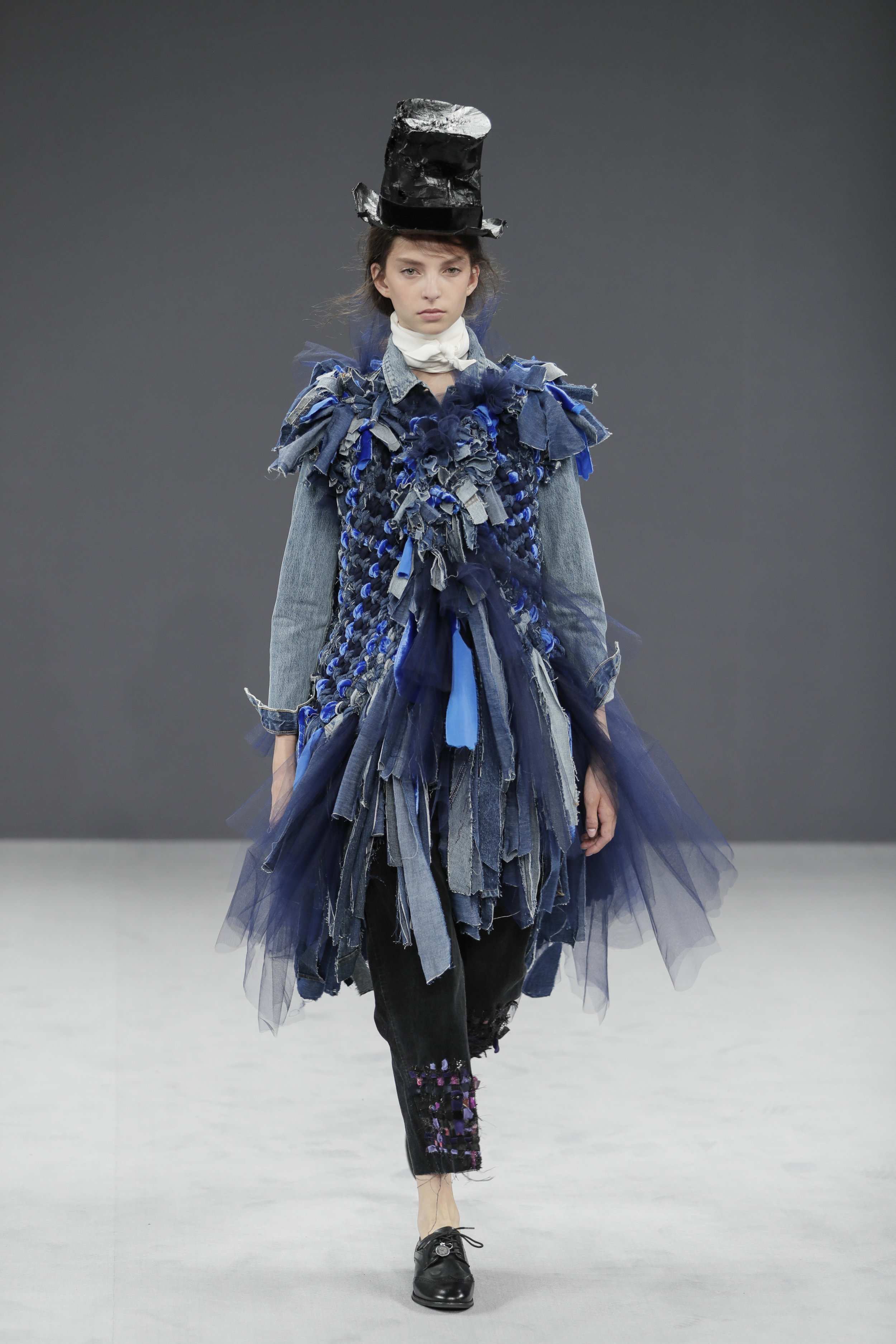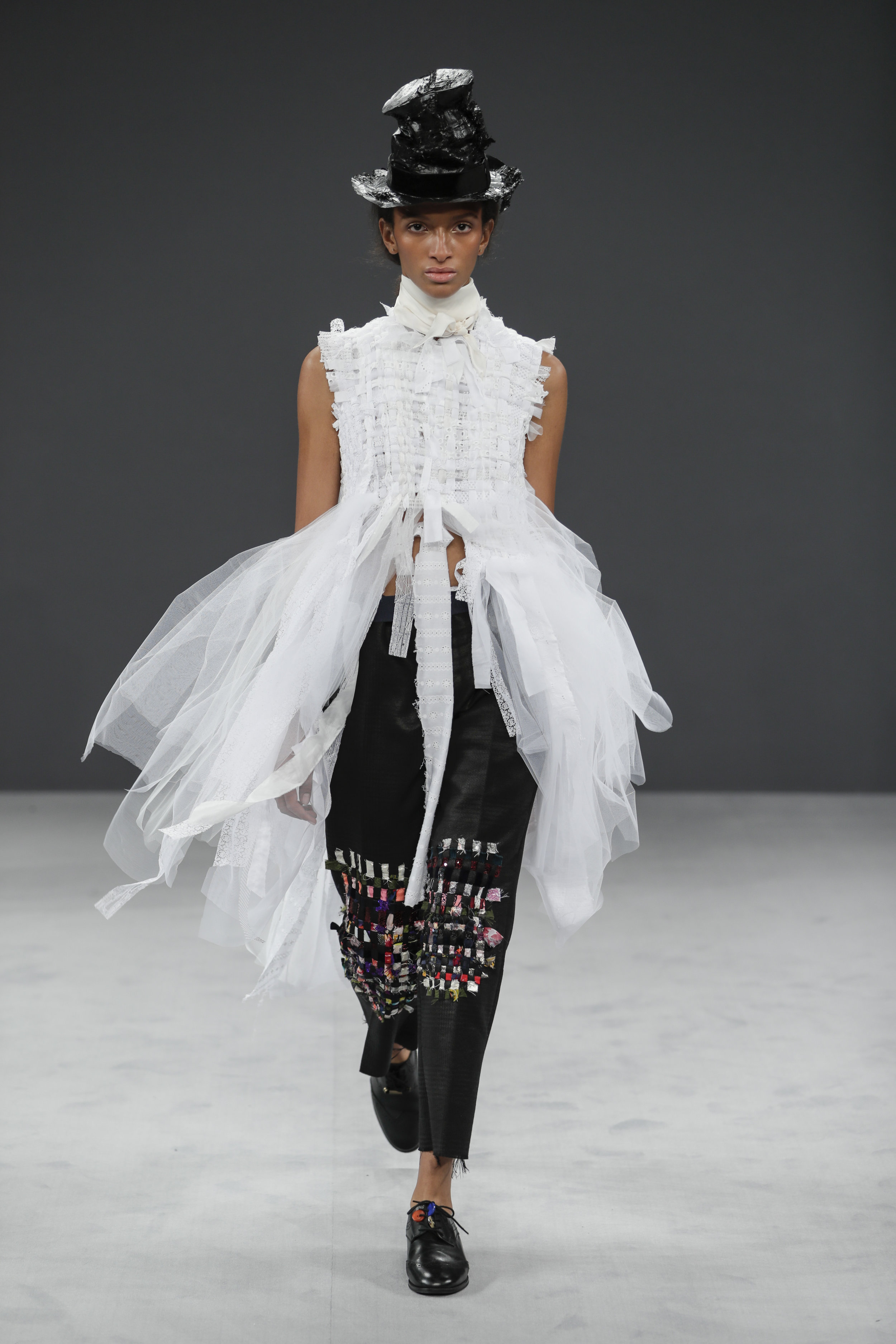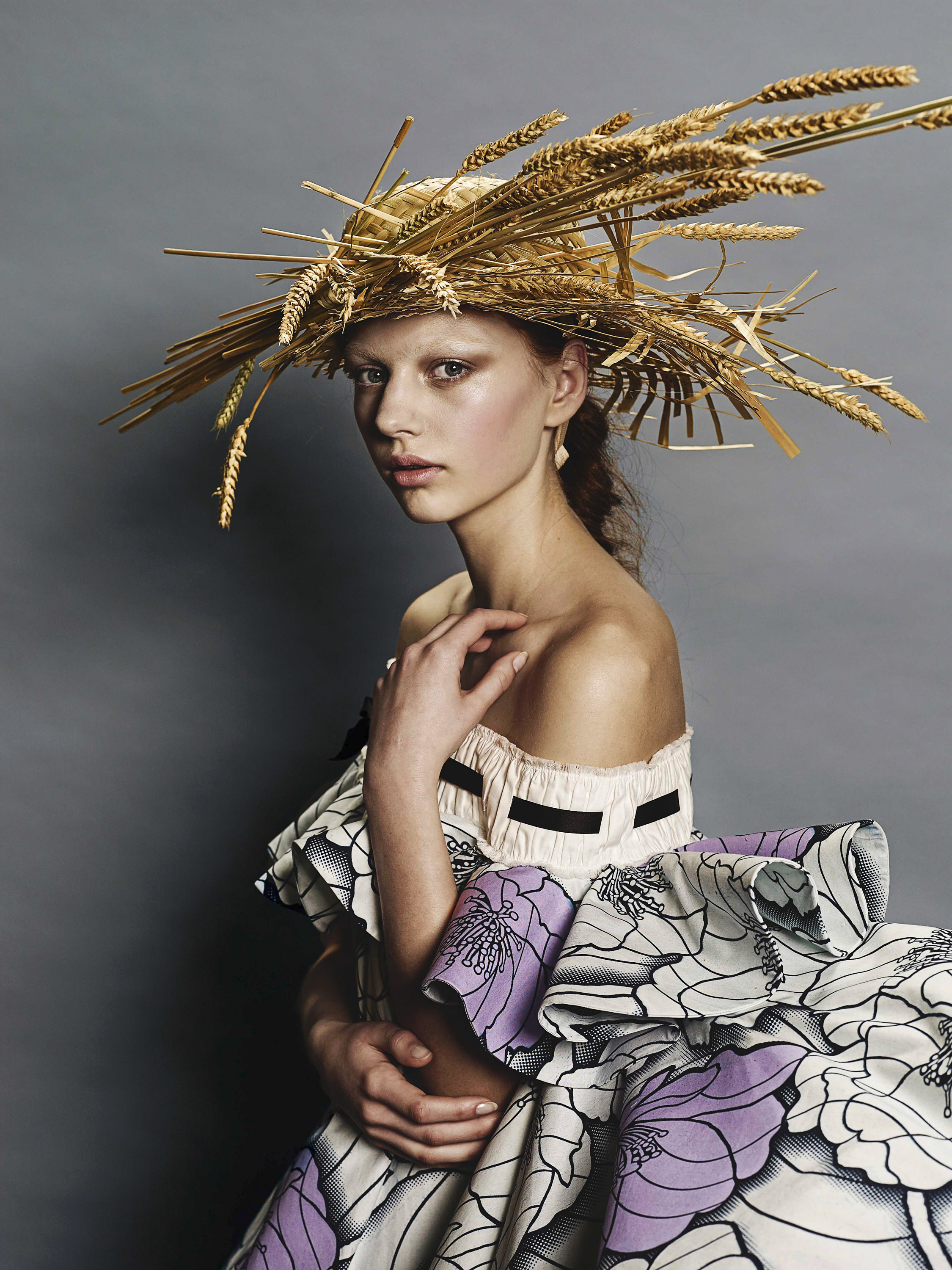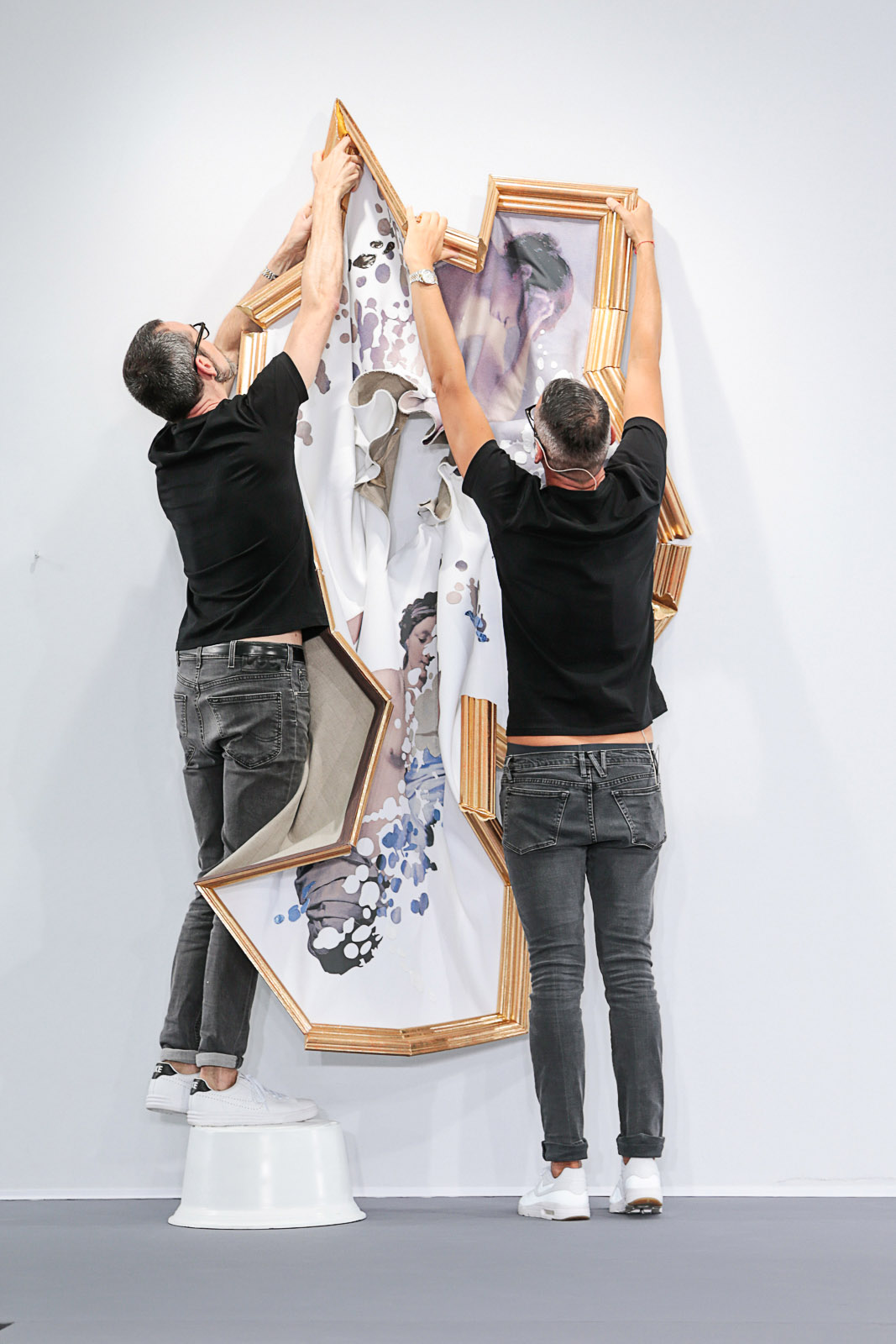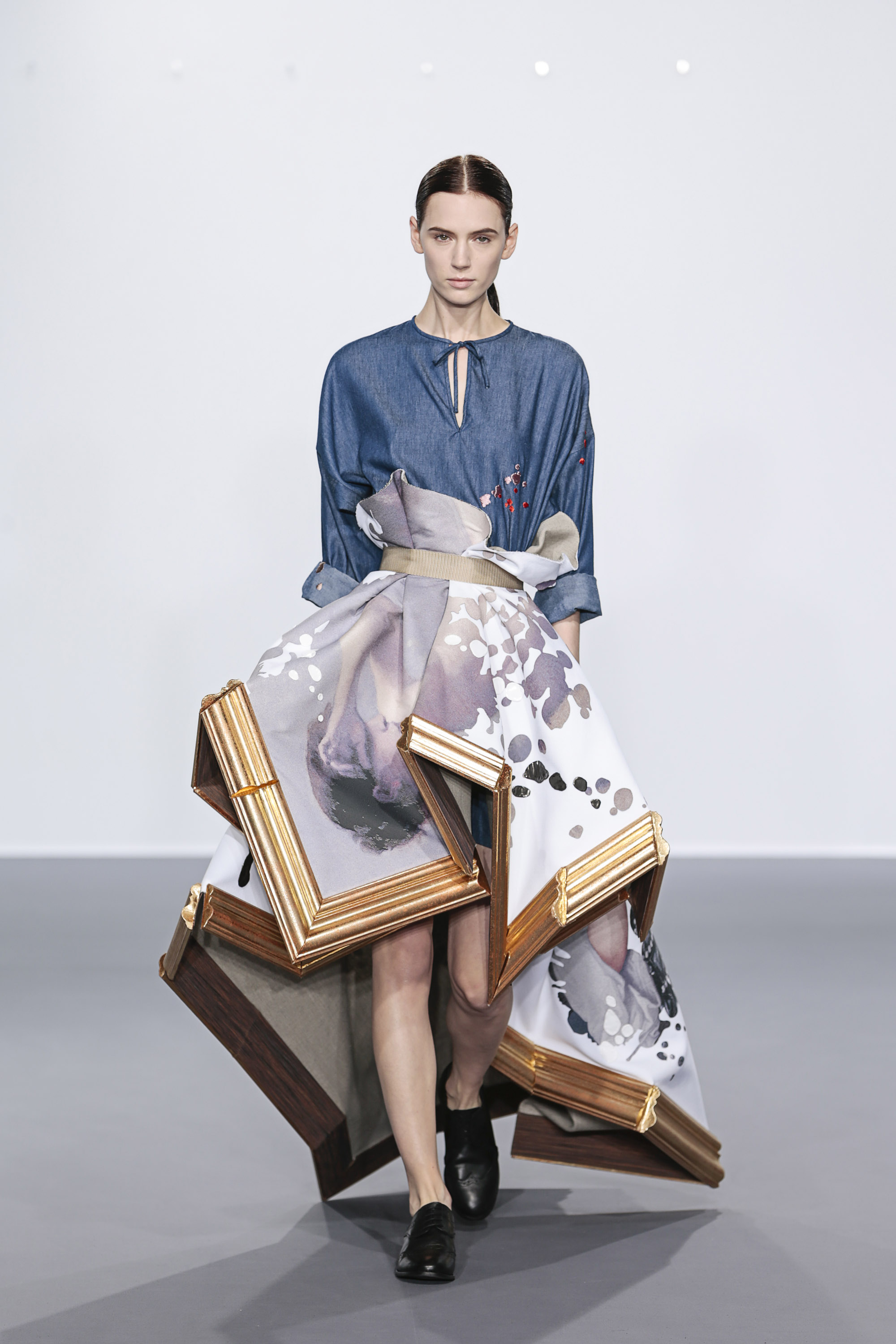An Interview with Viktor & Rolf, Two Fashion Artists
For their most recent haute couture collection in Paris, Viktor Horsting and Rolf Snoeren — aka Viktor & Rolf — recycled their past collections, sending down the runway creations that solely used fabrics and decorations left over from previous seasons or existing garments that they deconstructed and reconstructed. Dozens of strips of fabrics were woven or braided together to create a new jacket, the sleeves of a former military coat, or knee patches on a pair of vintage jeans. Old sequins and vintage buttons found a new lease of life stitched as embellishments, while strips of fabrics were ruched to decorate an old sweater and exaggerate volume.
VIKTOR & ROLF HAUTE COUTURE FALL/WINTER 2016
This “haute” recycling reflects the Dutch designer’s thoughtful attitude to design, using the old to create the new. But at a time when their creations are about to enjoy their third important museum exhibition, the collection also seems to bring the designers full circle with reminders of the collection that launched their careers back in 1993 when they won the top prize of the Hyères fashion festival: Titled “Detachment,” that first couture collection had also pieced together clothing fragments, reconstructing and layering clothes, and the overall silhouette (a short bust and oversized ball gown skirt) could be found again in the 2016 Fall/Winter Collection.
“I guess you could say it was already all there in the very first collection,” Snoeren says in an interview, shortly after the presentation.
“Detachment” had been created shortly after the duo moved to Paris, having graduated from the Arnhem Art Academy. “We were living in a very small apartment that we shared with other people and we felt very small, vulnerable, and unimportant, but also very creative,” recalls Snoeren, “We had no idea how to move forward. We decided to participate in that contest to show the work. This idea of vulnerability led us to thinking about layering. And Paris was very gray. We saw a lot of homeless people, a lot of misery. The collection started with that emotion, the emotion of detachment, the feeling of separation from society.”
Fast forward to 2016, and the new “Vagabond” collection (which uses leftover silver sequins from 1993, amongst other items) came from a very different feeling. “We’d just come off a collection that was very pristine and white, precise and sculptural, and we wanted to do something that was very organic, get our hands dirty kind of feeling,” explains Snoeren, with Horsting adding, “it came from what we’ve always done, conscious designing, but really taking it more literal and thinking about recycling and how we can recycle our own past and create something new from things that are already existing.” Snoeren continues, “Maybe subconsciously, [the exhibition] also played a part [in the latest collection]. Somehow, it does make sense that there is this exhibition [and] we’re doing a collection like this; also the fact that we stopped ready to wear last year, so we’re taking stock and moving towards the future.”
The collection references Charles Dickens’s street urchin look, accessorized with black brogues and paper top hats for the catwalk. Other recent collections had referenced Cubist sculptures, fashion as an art form, and Van Gogh fields - though the designers confided this was more a last minute analogy: “Originally we were inspired by VLISCO fabrics. We wanted to create the essential summer outfit, a straw hat, a flower dress, and flip-flops and see how extreme we could go, making it surreal. It really wasn’t about Van Gogh, then a week before, a friend remarked it was just like a Van Gogh painting, and we thought it was a good hook,” Snoeren confesses.
Explaining their creative process, Horsting says: “We don’t start the season with a photo or a mood board. We don’t work like that. We always start with language. For us, it’s much more important than any visuals. For example with the art collection, we had just stopped ready to wear to return to couture and we thought ‘What is couture for us, what does it mean to us?’ and that’s when wearable art came to our mind, because that’s what we’ve always thought about couture: first and foremost, it’s a laboratory for experimentation. So the term ‘wearable art’ was on the table, then we thought about visualizing it. And then it was, ‘perhaps you can wear a painting,’ and this stuck in our mind and we started trying it out. That’s an example of how we start with an idea.”
The designers have worked together for so long that they often complete each other’s sentences. “It fell into place from day one and it still does. Somehow we work together in a very organic way. We’ve never really divided who does what,” says Snoeren, followed by Horsting adding, “and we’ve never really analyzed who does what, because it’s such a mystery, even to us, but it just works.”
By using pieces from almost all of their earlier collections, the duo wove their own fashion history in this collection. “A bit like modern fashion archaeology,” remarks Thierry-Maxime Loriot, who is curating an exhibition of the designers’ work: “Viktor & Rolf: Fashion Artists,” which opens on October 21st at the National Gallery of Victoria, Melbourne.
The designers have already enjoyed a monographic exhibition at the Musée de la Mode et du Textile in Paris in 2003, as well as the Barbican in London in 2008, but Loriot, who worked on the hugely successful Jean Paul Gaultier exhibition that toured internationally, is quick to point out that the Melbourne exhibition will not be a retrospective.
“It will be more about looking to the future than looking to the past,” he explains, “it’s more like a contemporary installation, and showing different aspects of creation and how two designers come into one mind. I think it’s very fascinating to see how they can work together. I hate to make this comparison but they’re a bit like Gilbert & George.”
The Melbourne exhibition will include 35 couture creations borrowed from the duo’s archive as well as international museum collections, along with some new pieces created especially for the exhibition, and a display of replicas of antique Victorian dolls dressed in Viktor & Rolf’s most iconic looks. The designers had first created a dolls’ house installation for the Atrium of the Barbican, creating miniature versions of their runway looks for the dolls, re-proportioning them to fit perfectly. Since then, they have recreated a few doll-sized dresses for each collection. “With the dolls’ house, we wanted to show that everything we’ve done, even though it’s all separate seasons, to us it’s like one,” explains Horsting. “Also we like the idea of putting contemporary fashion on historically inspired dolls; it changes the time aspect, you look at it in a different way,” adds Snoeren.
There will be many surprises, Loriot promises, among which is a sound piece from 1996 when the designers recorded young children reciting their ABCs using the names of top models like Christy, Linda, Naomi.
Loriot says he was impressed by the “pure creativity” of the designers: “They don’t work with mood boards and I don’t think I’ve ever seen a fashion magazine at their place. It’s not like they are inspired by fashion, and for me that’s quite interesting, it’s almost pure creation and that’s why when you look at the pieces in the exhibition some are from 1993, some are yesterday, but you cannot say this is very ‘90s, it doesn’t follow trends so you cannot date anything. They set the trend and opened the doors to many people.”
Snoeren recognizes they have always striven for timelessness, being the “opposite of what fashion is, which is always in the now.” But he also adds, “We always want to hold onto things, create fashion to grow old. We even once dipped the whole collection in silver, [after] an old Dutch fashion of dipping baby shoes into silver to keep the memory.”
Loriot is hopeful the exhibition will travel and is already in negotiations with museums to that effect. “It has to travel; it’s such a unique moment and opportunity to have access to these clothes, which are like artworks.”
As published in the Fall issue of Blouin Lifestyle Magazine
